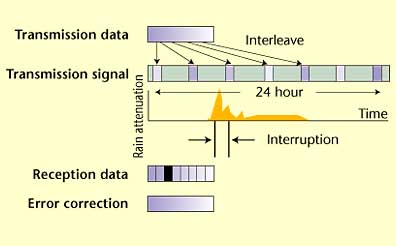|
Advanced Satellite Broadcasting System
Toward the realization of a 21 GHz-band satellite broadcasting system
 Toshihiro
NOMOTO, Senior Research Engineer, Toshihiro
NOMOTO, Senior Research Engineer,
Digital Satellite Broadcasting Systems
Radio waves are more affected by rain attenuation at higher frequencies.
The current satellite broadcasting system utilizes the 12 GHz-band,
and a future 21 GHz-band broadcasting system is under examination. In
such high frequency satellite broadcasting, techniques to overcome signal
attenuation due to rain will be of increasing importance. For this reason,
we are conducting research on the following techniques:
 |
Variable beam pattern satellite system
Heavy rainfall tends to occur in only a limited area at any one
time. This satellite system uses a large scale phased array antenna
to concentrate the emission beam on the area of heavy rainfall and
compensate for rain attenuation. (Figure 1) |
 |
| Figure 1: Variable beam pattern satellite system |
 |
Super-long-period interleave scheme
This technique is under consideration for use with recorded programs.
In this scheme, the transmitting signals are interleaved for a long
time span such as 24 hours. The receiver accumulates the interleaved
data and properly decodes (de-interleaves) the data. A partially
damaged signal due to rain attenuation can be recovered, or restored
to a complete signal by error correction after de-interleaving.
(Figure 2) |
 |
| Figure 2: Super-long-period interleave transmission |
In addition to the basic studies, we are presently examining the degree
of rain attenuation, size of rainfall areas, and duration of rainfall
based on fixed point observation at reception monitoring stations and
AMeDAS* rainfall data. We are seeking to establish the necessary beam
width, radiation power, interleave period etc. to make the 21GHz system
and higher frequencies available for satellite broadcasting.
*Automated Meteorological Data Acquisition System |

 Toshihiro
NOMOTO, Senior Research Engineer,
Toshihiro
NOMOTO, Senior Research Engineer, 
